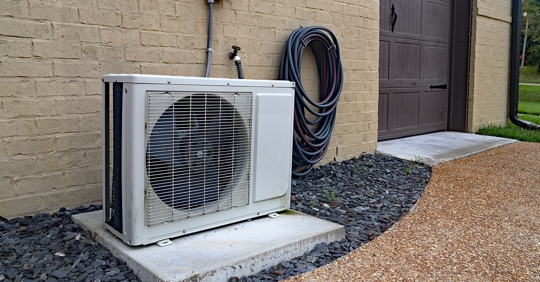Families looking to lower their carbon footprint (and energy bill) should evaluate their HVAC system. New heating and cooling options like ductless mini splits offer exceptional performance with hassle-free installation. Is a ductless air conditioning or heat pump system right for you? Here’s what you need to know.
What is a ductless mini split?
In short, a ductless mini split is an HVAC system without ductwork! Most heating and cooling systems generate treated air (heated or cooled) from a central location before distributing to various parts of the home. A ductless mini split delivers warm or cool air from a decentralized point in the house, typically where your family needs it most, such as the living room or kitchen.
How does a mini split work?
A basic ductless system includes two units.
- The indoor unit is wall-mounted and features an evaporator coil similar to a traditional AC unit.
- The outdoor unit is usually wall-mounted and uses a compressor to pump liquid refrigerant to the indoor unit.
The two units are connected through the wall with electrical wiring and tubes. One set of tubing delivers the refrigerant to the indoor unit, where it evaporates and captures hot air and humidity. During this process, it transforms into a gas and is pumped back outside.
Do ductless mini splits heat and cool?
Only ductless heat pump systems can both heat and cool your home. These units are more expensive but can be used year-round as needed. Some households opt for ductless mini split air conditioning units based on their needs.
Single-zone and multi-zone ductless mini splits
Depending on how many rooms in your home you need to heat or cool, you may need to decide between a single-zone and multi-zone system.
- A single-zone ductless mini split is one-to-one; it features one indoor unit and one outdoor unit and cools a single space.
- A multi-zone ductless mini split covers a bit more ground. Using a higher capacity outdoor unit, multi-zone systems utilize up to 5 indoor units to heat or cool your whole home. Multi-zone systems are more expensive, but they’re modular; you can start with two units and add more as needed!
The pros and cons of a ductless mini split
Could a ductless system be a good fit for your home? Your Cunningham HVAC technician can walk you through the decision-making process and provide an in-home assessment. Here are a few things to consider until you give us a call:
Pros of a ductless mini split
- Easy to install
- Focused heating or cooling
- Reduced energy consumption
Cons of a ductless mini split
- Wall-mounted indoor units are visible.
- Upfront expenses can be cost-prohibitive.
Are ductless mini splits more efficient?
Energy efficiency is a key benefit of ductless mini splits. Almost all ductless mini-split models have better energy efficiency ratings than traditional AC units or furnaces.
- Conventional central AC unit: 3,000 to 3,500 watts per hour
- Mini split AC unit: 2,000 watts per hour
Choosing the right spot to install your indoor unit also impacts efficiency. We’ll work with you to identify the right room to install your system to distribute airflow without detracting from the look and feel of the space.
Is a ductless system right for you? Let us help you decide!
Now more than ever, families are looking for innovative ways to reduce their carbon footprint and save money every month on their energy bills. Working with an experienced Cunningham HVAC technician is a fantastic way to see if a ductless HVAC system is right for your Atlanta home. We can also find other ways to lower energy expenses with the latest HVAC and water heaters technologies. Schedule an appointment or call (770) 343-7565 today.

